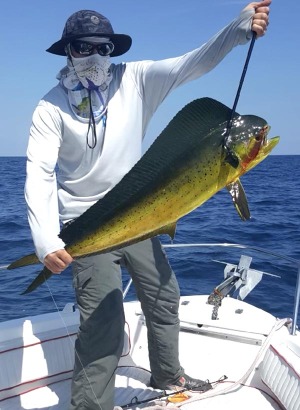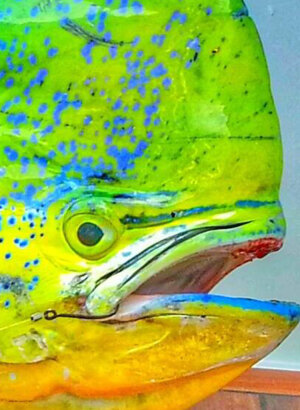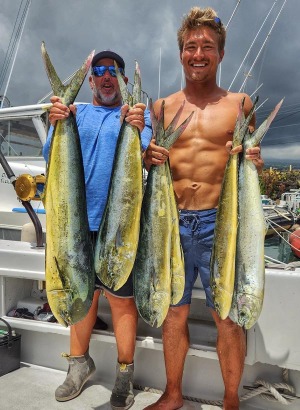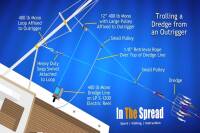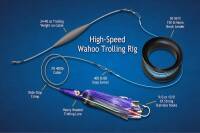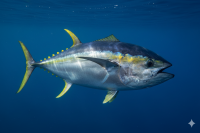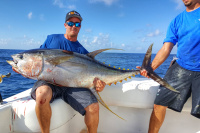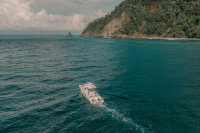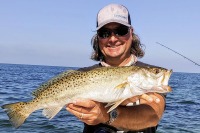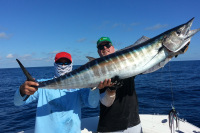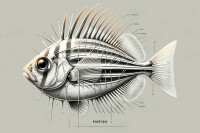Learn proven tackle selection strategies for consistent mahi-mahi success. From budget-friendly spinning setups to professional conventional gear, this comprehensive guide covers essential rods, reels, leaders, and rigging techniques that produce results in any offshore dolphin fishing situation.
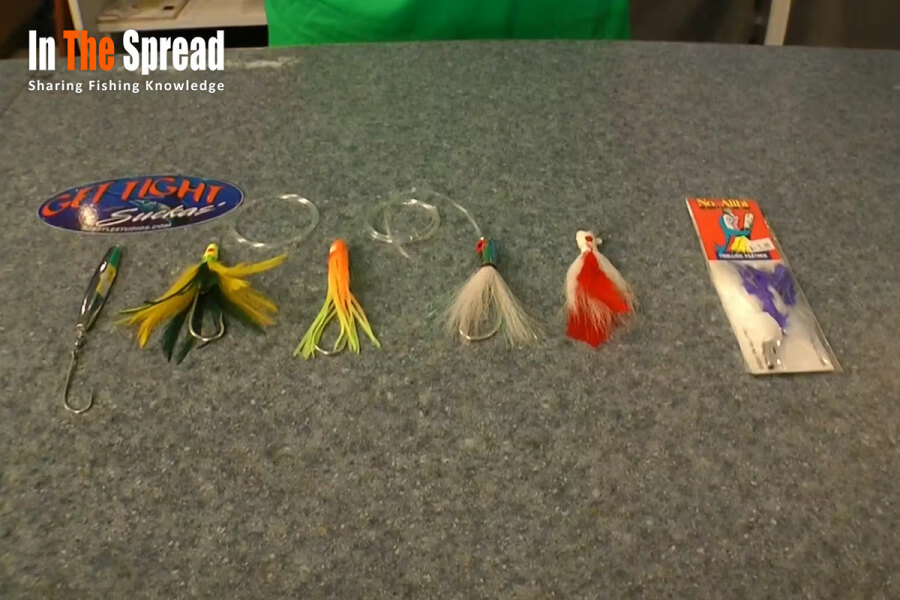
Complete Mahi Mahi Fishing Tackle Guide
Dolphin Mahi Mahi Fishing
Mahi-mahi or dolphin fishing represents one of offshore angling's most rewarding pursuits, where aggressive dolphins provide spectacular fights and excellent table fare. These voracious feeders, often described as "wild starving dogs at a bowl of fresh meat," make dolphin fishing surprisingly simple compared to other offshore species. The key lies in understanding how proper tackle selection, environmental factors, and presentation techniques work together to maximize your success on the water.
Understanding Mahi-Mahi Behavior and Environmental Influences
Successful mahi mahi fishing begins with understanding how these remarkable fish respond to environmental changes. Mahi mahi feeding patterns fluctuate dramatically based on lunar phases, with full moon periods presenting unique challenges that require specific tackle adjustments. During bright moon phases, dolphins feed extensively throughout the night, arriving at daybreak already satiated and extremely selective about bait presentations.
This behavioral shift demands a complete change in tackle strategy. When the moon is full and bright, dolphins become finicky feeders that will inspect baits carefully, often nosing live pilchards without striking. Conversely, during new moon and quarter moon phases, these same fish attack chunks of ballyhoo or bonito with reckless abandon, allowing anglers to use heavier tackle and simpler presentations.
Seasonal mahi mahi fishing patterns also influence tackle selection significantly. Spring migrations along the Atlantic coast bring peak fishing opportunities from April through June, when dolphins concentrate in 400-600 foot depths along temperature breaks and current edges. Summer fishing typically moves to deeper waters, requiring heavier tackle to reach fish holding beyond the continental shelf. Fall returns provide excellent opportunities as dolphins follow bait schools back toward temperature breaks in moderate depths.
Rod and Reel Setups for Maximum Versatility
Choosing the right rod and reel combination forms the foundation of effective mahi mahi fishing. Modern tackle offers unprecedented versatility, allowing anglers to battle virtually any size mahi with properly matched equipment. The debate between spinning and conventional tackle continues among serious mahi anglers, with each system offering distinct advantages depending on fishing conditions and target size.
Spinning setups for mahi mahi have gained tremendous popularity due to their casting versatility and effectiveness with schooling fish. A quality 7-foot medium-heavy to heavy spinning rod provides the perfect balance of sensitivity and power for mahi fishing. The fast or extra-fast action offers excellent hook-setting capability while providing the backbone needed for controlling strong-running fish.
Essential specifications include:
- Line rating: 16-30 pound test capacity for versatility across fish sizes
- Action: Fast to extra-fast for optimal sensitivity and hook sets
- Length: 7 feet for casting distance and fish control
- Guides: Stainless steel with ceramic inserts for braid compatibility
Solid spinning rod recommendations include the St. Croix Legend Trek Medium Heavy, Shimano Teramar series, and TackleDirect Platinum Hook series. These rods feature high-modulus graphite construction with corrosion-resistant guides specifically designed for saltwater applications.
For spinning reels, choose 4000-8000 series models with gear ratios between 5.2:1 and 6.2:1. This moderate speed provides the perfect balance of power and retrieve rate, crucial for controlling strong-running mahi while maintaining line capacity for long fights.
Premium options include:
- Shimano Saragosa 8000: Bulletproof reliability with superior corrosion resistance
- Penn Spinfisher VI series: IPX5 sealing protection against saltwater intrusion
- Daiwa BG MQ series: Exceptional value with solid construction and smooth drag
Conventional tackle for mahi mahi excels in trolling applications and when targeting larger bulls around structure. The shorter 6'6" to 7' rod length provides better leverage for boat fishing, while the 16-50 pound line class rating handles everything from schoolies to trophy fish. Conventional rods should feature moderate to fast action for shock absorption during aggressive strikes.
Conventional reel selection focuses on high-speed retrieve ratios of 3.8:1 to 4.2:1, allowing quick line recovery when mahi make their characteristic direction changes. Lever drag systems provide precise control throughout the fight, with 15-25 pound strike settings and maximum drags of 25-35 pounds.
Top choices include:
- Shimano Talica 20II/25II: Premium performance with advanced drag technology
- Penn International 20VISX: Proven tournament reliability with smooth operation
- Accurate BV2-800: High-quality construction with exceptional drag performance
Line and Leader Systems for Stealth and Strength
Line selection has evolved dramatically in recent years, with braided mainlines becoming the standard for serious mahi anglers. Braided line offers numerous advantages over traditional monofilament, including zero stretch for better sensitivity, smaller diameter for increased capacity, and superior casting distance. For spinning setups, 30-50 pound test braid provides the perfect balance of strength and manageability, while conventional tackle typically uses 50-80 pound braid for trolling applications and heavy structure fishing.
The key to successful braid fishing lies in proper connection to mono or fluorocarbon topshots. Hollow core braids like Jerry Brown or Power Pro Hollow allow seamless splicing to monofilament topshots, creating strong connections without bulky knots that can catch guides during long casts or extended fights.
Monofilament topshots of 40-60 pound test over 100-200 yards provide essential shock absorption for trolling applications while maintaining spread visibility with hi-vis yellow colors. These topshots cushion the impact of aggressive strikes while allowing the use of thinner, more sensitive braid as the main line.
Fluorocarbon vs monofilament leaders represents one of mahi fishing's most critical tackle decisions. Fluorocarbon leaders have revolutionized mahi fishing due to their near-invisibility underwater and superior abrasion resistance. Use 30-50 pound test leaders measuring 3-6 feet for finicky fish or clear water conditions, while 40-80 pound test leaders extending 6-12 feet handle general fishing situations with excellent abrasion resistance.
Premium fluorocarbon options include Seaguar Blue Label and Sunline FC, which offer exceptional clarity and knot strength. These leaders prove especially critical during full moon periods when mahi become extremely line-shy and will refuse presentations with visible leaders.
Rigging Techniques for Every Situation
Effective mahi fishing requires mastering specific rigging systems designed for different conditions and fish behavior. Understanding when and how to employ these rigs dramatically improves success rates and helps anglers adapt to changing conditions throughout the day.
Live bait rigs for mahi fishing prove most effective during challenging conditions when fish become selective feeders. These situations typically occur during full moon periods, after extended fishing pressure, or when water conditions change rapidly. A proper live bait rig consists of a sharp 5/0 offset J-hook connected to 3-6 feet of 30-50 pound fluorocarbon leader, tied directly to the main line for natural presentation.
Essential components include:
- Hook selection: Mustad O'Shaughnessy 3407 or Big Gun series for penetration
- Leader length: 3-6 feet depending on water clarity and fish selectivity
- Connection method: Direct tie without swivels for natural bait swimming
- Bait attachment: Single hook through nose for optimal swimming action
Chunking rigs for mahi mahi dominate during active feeding periods when fish compete aggressively for food. These rigs work best during new moon and quarter moon phases when fish feed actively throughout daylight hours. Effective chunking rigs feature 4/0 to 6/0 J-hooks connected to 3-4 feet of 80-130 pound monofilament leader. The Mustad 7766D long shank hook remains the gold standard for chunking, offering excellent penetration while facilitating easy release of smaller fish.
Trolling ballyhoo rigs represent the backbone of consistent mahi fishing, allowing efficient water coverage while presenting natural baits attractively. These rigs use 6/0 to 8/0 J-hooks on 6-foot leaders of 60-100 pound monofilament. The pin-rig method, employing 1/2 ounce egg sinkers and #10 copper wire pins, creates natural swimming action that consistently attracts strikes from hunting mahi.
Bait and Lure Selection for Maximum Effectiveness
Bait choice often determines success or failure in mahi fishing, with live offerings consistently outperforming artificial lures when fish become selective. Understanding which baits work best in different situations, how to obtain them, and proper presentation techniques separates successful anglers from those who struggle consistently.
Live baits for mahi mahi reign supreme when conditions become challenging. Small blue runners caught under sargassum patches using sabiki rigs are considered the ultimate mahi bait by experienced charter captains. These baits trigger feeding responses even from finicky fish, often working when nothing else will. Blue runners possess natural characteristics that make them irresistible to hunting mahi.
Live pilchards offer excellent versatility for trolling, chunking, and pitch bait applications. These hardy baits survive well in live wells and present naturally when rigged properly, making them ideal for various fishing situations throughout the day.
Live ballyhoo with broken beaks bent at 90-degree angles swim with attractive wounded action that consistently triggers strikes from hunting mahi. This presentation mimics injured baitfish that mahi target preferentially in the wild.
Dead bait techniques provide reliability when live bait becomes unavailable or conditions favor different presentations. Medium-sized ballyhoo serve as the gold standard for trolling, offering consistent swimming action and widespread availability. Horse ballyhoo work perfectly as pitch baits when targeting larger fish or when schools appear on the surface.
Quality indicators for dead baits include clear eyes, clean silver sides, and bright orange coloration on bills and tails. Proper storage using vacuum-sealed bags with light brining extends bait life and maintains attractive colors throughout long fishing days.
Lure Selection for Artificial Presentations
While live and dead baits often outperform artificial lures, certain conditions favor artificial presentations that can dramatically outproduce natural baits. Understanding when and how to employ mahi fishing lures expands angling opportunities and provides solutions when traditional methods fail.
Trolling lures for mahi mahi excel in heavily weeded areas where natural baits become fouled with sargassum. Feathered lures in hot pink and bright green consistently produce strikes while their streamlined design sheds weeds effectively. These colors have proven themselves over decades of mahi fishing across different regions and conditions.
Chugger lures with concave heads create distinctive noise and bubble trails that attract mahi from considerable distances while picking up fewer weeds than natural baits. Modern chugger designs incorporate enhanced features for improved effectiveness in various sea conditions.
Sea witch skirts in blue/white and green/pink/chartreuse combinations provide versatile trolling options that work across different water conditions and bait presentations. These proven color combinations consistently trigger strikes from aggressive mahi.
Environmental and Seasonal Factors
Lunar cycles profoundly influence mahi behavior and feeding patterns, requiring tactical adjustments that mean the difference between exceptional fishing and disappointing results. Understanding how to modify tackle and techniques based on moon phases gives serious anglers significant advantages.
Full moon challenges stem from increased nighttime feeding activity that leaves fish satiated and selective during daylight hours. During these periods, mahi often nose baits without striking and generally exhibit reduced aggression. Successful full moon fishing requires switching to live bait exclusively, using lighter fluorocarbon leaders, and focusing fishing efforts during dawn and dusk periods when feeding activity resumes.
New moon and quarter moon advantages create optimal mahi fishing conditions as reduced nighttime visibility limits feeding activity, concentrating hunger during daylight hours. Fish feed more aggressively and show less selectivity, allowing standard trolling techniques and lure presentations to work effectively. These periods often produce the highest catch rates of the lunar cycle.
Seasonal patterns significantly impact tackle selection and fishing strategies. Spring Atlantic fishing from April through June targets fish in 400-600 foot depths along temperature breaks and current edges. Summer fishing typically moves to deeper waters requiring heavier tackle to reach fish beyond the continental shelf. Fall fishing near temperature breaks allows lighter tackle to excel as fish move back toward shallower waters following bait schools.
Matching Tackle to Fish Size
Proper tackle selection based on target fish size ensures optimal performance while preventing equipment failures during critical moments. Mahi size considerations vary significantly between different fishing areas and seasons, requiring tactical adjustments to maximize success.
Schoolie mahi weighing 5-15 pounds respond excellently to light tackle setups featuring 7-foot medium spinning rods, 20-30 pound braid, and 20 pound fluorocarbon leaders. This lighter tackle provides enhanced sensitivity for detecting subtle strikes while offering sufficient power for controlling smaller fish efficiently.
Bull and cow mahi exceeding 20 pounds require heavier tackle with 7-foot heavy action rods, 50-80 pound line, and 50-80 pound fluorocarbon leaders. The increased strength prevents break-offs during powerful runs while providing the leverage needed to control large fish around structure or in current.

Professional Tips and Industry Trends
Modern mahi fishing continues evolving as technology advances and angling pressure increases. Professional charter captains have developed sophisticated techniques that consistently outperform traditional methods, particularly in heavily pressured areas where mahi have become educated to standard presentations.
Charter captain preferences emphasize conventional tackle for serious mahi fishing, using 6'6" to 7' medium-heavy action rods with high-speed retrieve reels for trolling applications. However, the growing acceptance of spinning tackle among professionals reflects its casting versatility and effectiveness with schooling fish, particularly when sight fishing to scattered mahi.
Dink rig techniques using light spinning tackle with 20-pound fluorocarbon topshots and 3/0 Gamakatsu live bait hooks are employed by charter captains "95% of the time" for line-shy fish in heavily pressured areas. These ultra-light presentations often trigger strikes when heavier tackle fails completely.
Budget Considerations for Every Angler
Effective mahi fishing doesn't require expensive equipment, though quality components prove cost-effective over time when exposed to harsh saltwater conditions. Understanding where to invest money for maximum impact helps anglers build capable setups without exceeding budgets.
Entry-level setups provide excellent performance for recreational anglers. A Penn Spinfisher VI 4500 paired with a 7-foot medium-heavy rod offers tournament-level capability at $200-250. This combination handles everything from schoolies to occasional large fish while providing reliable saltwater performance.
Mid-range tackle combinations represent the value sweet spot for regular mahi anglers. St. Croix Legend Trek rods paired with Shimano Spheros or Saragosa reels offer enhanced drag systems, improved corrosion resistance, and better overall refinement at $300-600 price points.
Professional-grade equipment starts around $600-800 for rod and reel combinations, extending to $1500+ for premium setups. Shimano Talica 25II reels with custom rods provide tournament-level performance for serious anglers who fish regularly in challenging conditions.
Maintenance and Longevity
Proper maintenance represents the most cost-effective way to extend tackle life and ensure reliable performance when targeting mahi offshore. Saltwater's corrosive nature demands consistent care routines that prevent expensive repairs and equipment failures during critical fishing moments.
Post-trip maintenance should begin immediately upon returning to dock. Rinse all tackle with fresh water, paying special attention to reel internals and rod guides. Gently hose down equipment while operating reel handles to flush salt from bearings and drag components. Store spinning reels upside down during rinsing to prevent water intrusion into gear boxes.
Routine maintenance schedules for frequent users include weekly deep cleaning with mild soap solutions, light lubrication of moving parts, and detailed inspection for corrosion or wear. Monthly full inspections should address potential problems before they cause failures, while annual professional reel service costing $50-100 prevents costly repairs and ensures optimal performance.
Professional technicians replace worn drag washers annually, update lubrication systems, and address potential problems before they cause failures. This investment typically pays for itself through extended equipment life and improved reliability during crucial fishing moments.
Conclusion
Successful mahi fishing ultimately depends on understanding how tackle selection interacts with environmental conditions, fish behavior, and presentation techniques. While budget-friendly setups can prove highly effective, investing in quality components designed for saltwater use provides long-term value through reliability and performance. The key lies in matching tackle to specific situations—light spinning gear for schoolies, heavy conventional tackle for bulls, and maintaining backup equipment for inevitable challenges that occur during extended offshore fishing sessions.
Quick Reference Checklist:
- 7' medium-heavy spinning rod with 4000-6000 reel and 30-50 lb braid
- 6'6"-7' conventional rod with lever drag reel and 50-80 lb braid
- 30-80 lb fluorocarbon leaders and 40-60 lb mono topshots for trolling
- Live/dead baits: blue runners, pilchards, ballyhoo, squid
- Lures: feathers, chuggers, sea witch skirts in proven colors
- Maintenance kit: freshwater rinse, soft cloth, lubricant, VCI strips
Login
to leave a review.
User Reviews
There are no reviews yet.Complete Dredge Pulley Setup Guide
Saltwater
12.28.2020
High Speed Wahoo Trolling Rig
Saltwater
09.07.2018
Best Bait for Wahoo
Saltwater
12.30.2023
Pinfish - A Comprehensive Guide
Saltwater
11.10.2023
0


